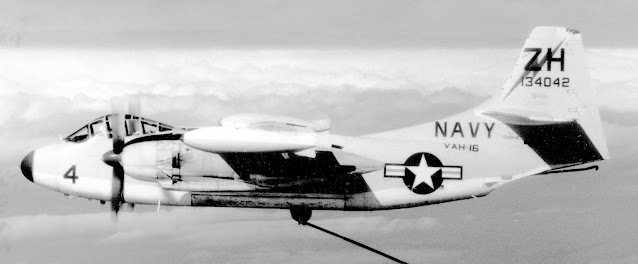The AJ Savage, the U.S. Navy's first carrier-based bomber that could carry the 10,000# Mk 4 nuke was not only big (humongous, really), folding it required so much time and effort that it wasn't done unless the Savage was a "dud" that had to be taken down into the hangar (see http://tailhooktopics.blogspot.com/2022/10/aj-savage-wing-and-fin-fold.html).
The hose reel and drogue-deployment mechanism was mounted on the back of the tank (the drogue is in the retracted position):
A small opening was provided in the bomb bay doors so the drogue mechanism could be deployed below the fuselage (because of the size of the drogue, the doors had to be opened to lower the drogue and then closed again).
The right side of the hose reel (the drogue is not present):
Note that the fuel from the tank to the reel is provided by a line on the left side of the tank that extends from its bottom up and over the reel, attached to it from the side (3).
The hose was fed down from the reel to the front side of the big pulley on the drogue mechanism and then aft to the drogue itself.
The drogue at this point was a metal cone.
This is a prototype of the external mechanism being tested on an XAJ-1:
The operation of the refueling system was the responsibility of the rearward facing crewman on the AJ-2:
At least one AJ-1 was equipped for inflight refueling and assigned to NATC but I don't know where these panels were located on it (the AJ-1's third crewman's position was in the compartment below the flight deck).
I don't have any three-view or station drawings of the refueling mechanism or the opening in the bomb bay doors but in the event that a modeler feels the need to add them to a kit, these pictures will help locate and size them.













Re: "...the AJ Savage was literally designed around the Mk 4 nuclear bomb...." the statement is true, but by the time the production models arrived to the fleet, the 4-ton Mk 6 version had replaced the Mk III and Mk IV, 5-ton "special weapons" — without the nuclear cores controlled by the civilian Atomic Energy Commission — that had been loaded on the 3 Midway and 1 Essex aircraft carriers in 1950 after the Korean War began. However this is a distinction without a difference, as the size and shape of the Mk 6 was the same as the earlier bombs. Also (pedanticly!) originally the bomb versions were identified with the Roman Mark I through Mark V, than the Arabic Mark 6 and following.
ReplyDeletePS: The first Naval Air strategic nuclear bombers, i.e., Heavy Attack — 1 P2V-2C and 11 P2V-3C Neptunes in VC-5, VC-6, and VC-7 — did carry the Mark III and Mark IV Special Weapons.
I was an analog computer specialist (AT, then AQ, with Special NEC) for the ASB-1a Bomb Director System in HATU and in VC-8 in 1954/1955. VC-8, with P2V-3B Neptunes, then AJ-1 Savages, was established as the Research and Training squadron as Navy Heavy Attack Neptunes and Savages transitioned from the Norden Bombsight to the Norden-Ketay CP-66 analog computer, the "brain" of the integrated ASB-1 Bomb Director System. In 1954 VC-8 transitioned to an Heavy Attack role.
Regarding the USS Coral Sea photograph via Greg Bishop, underway with 5 AJ Savages covering half the usable flight deck, I served aboard with VC-8 Savages when she was still a straight deck.
ReplyDeleteNote that ALL aircraft had to be moved the length of the flight deck fore and aft during each flight quarters' cycle, which is why in normal deployments to the 6th Fleet and 7th Fleet the bulk of the Savages in Heavy Attack squadrons (VC-5, 6, 7, 8, 9) remained on forward deployed NAF/NAS bases, with 2 Savages in Dets on the carriers.